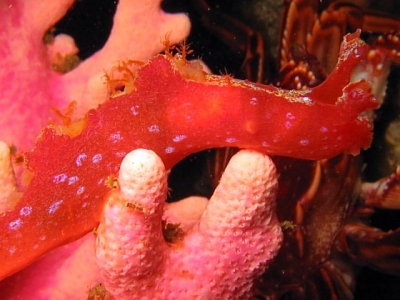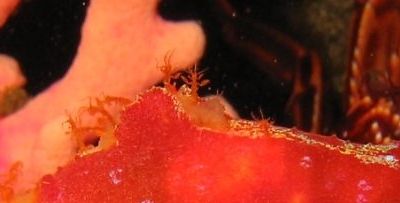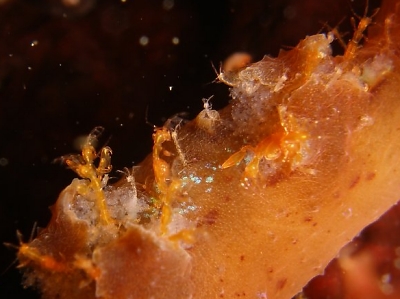Notobryon wardi - caprellid symbiosis?
July 13, 2007
From: Guido Zsilavecz


Good day Bill!
While photographing Notobryon wardi I concentrated on its odd gills with an attempt to finally see what they really look like. On viewing the images later I noticed a group of caprellid amphipods hitching a ride there. Thinking it was a once-off scenario, I checked my other photos and found a number of them showing caprellids as well, and on subsequent dives found the same again. I can imagine that the caprellids are happy to have a mobile perch, but could the N. wardi get something out of it? Is this a known phenomena?
Locality: Oudekraal, Cape Town, 10m, South Africa, Atlantic, 16 December 2006, Subtidal. Length: 5cm. Photographer: Guido Zsilavecz.
The two images are of different animals.
Thanks,
Guido Zsilavecz
guido@surg.co.za
Zsilavecz, G., 2007 (Jul 13) Notobryon wardi - caprellid symbiosis?. [Message in] Sea Slug Forum. Australian Museum, Sydney. Available from http://www.seaslugforum.net/find/19058
Dear Guido,
What an interesting observation. I can't say I have heard of such an observation before but perhaps there is something in the amphipod literature - the natural sciences haven't been good at cross-referencing. What I have observed often is that hydroid-feeding nudibranchs tend to compete with caprellids on hydroid colonies. You seldom find both aeolids and caprellids together on the same colonies. I certainly don't bother looking for aeolids on hydroid colonies with caprellids. I always thought that the caprellids were eating the hydroids but I came across an interesting paper (Caine, 1998) which showed that caprellids are herbivores feeding on the algal film, diatoms etc, which cover the substrate. Caine found that the caprellid amphipod Paracaprella tenuis Mayer has a mutualistic relationship with the hydrozoan Bougainvillia rugosa Clark, and adult male caprellids would aggressively displace the nudibranch Tenellia pallida (Alder and Hancock) when itvwas attempting to eat the hydroid. He reports that when the nudibranch crawls within a body-length of the amphipod it is aggressively displaced by the caprellid. This means that hydroid polyps around the caprellid are protected from predation, and continued attacks often mean that the nudibranchs leave the whole colony. Caine hypothesises that through this behaviour the caprellid receives a suitable substratum and food in the form of attached diatoms and entrapped detritus.
I guess its difficult to compare the relationship of Notobryon and caprellids to that of Tenellia, which is similar in size to the caprellids. Notobryon is a hydroid feeder, but as caprellids are certainly found in other places than on hydroid colonies, its not that they are being advantaged by a free ride to the next hydroid colony. Perhaps being on a 'big' nudibranch affords some protection. I don't know, but I wonder if Notobryon feels itchy?. This relationship certainly deserves a serious study.
-
Caine, E.A. (1998) First Case of Caprellid Amphipod-Hydrozoan Mutualism. Journal of Crustacean Biology, 18(2): 317-320
Best wishes
Bill Rudman
Related messages
-
Re: Scyllaea pelagica? from sthn Queensland
From: Gary Cobb, October 16, 2008 -
Notobryon ? from nthn Mariana Islands
From: Takao Urasawa, April 17, 2008 -
Radula of Notobryon wardi
From: Bill Rudman, September 14, 2002 -
Notobryon wardi? from Mexico
From: Ali Hermosillo, September 14, 2002 -
Notobryon wardi? from west Mexico
From: Alicia Hermosillo, June 29, 2002 -
Notobryon from Hong Kong
From: Bernard Picton , May 23, 2002 -
Scyllaeidae from Bahia de Banderas, (2)
From: Alicia Hermosillo, May 18, 2002 -
Notobryon wardi from the Philippines
From: Erwin Koehler, August 9, 2001 -
Notobryon bijercurum or bijecurum?
From: Pauline Fiene-Severns, July 24, 2000 -
Notobryon wardi at Fly Point, Port Stephens
From: Ron Greer, May 30, 2000
